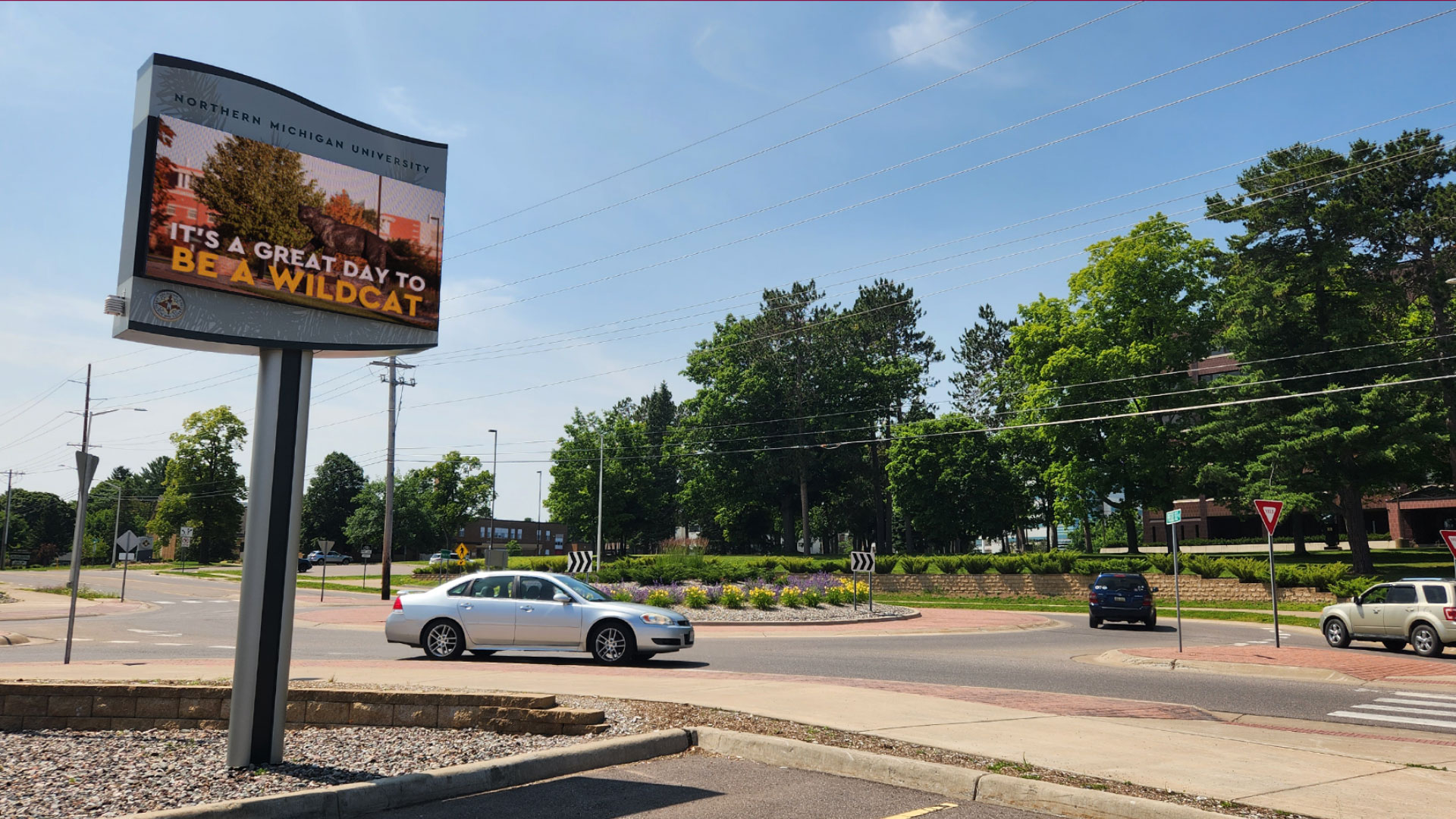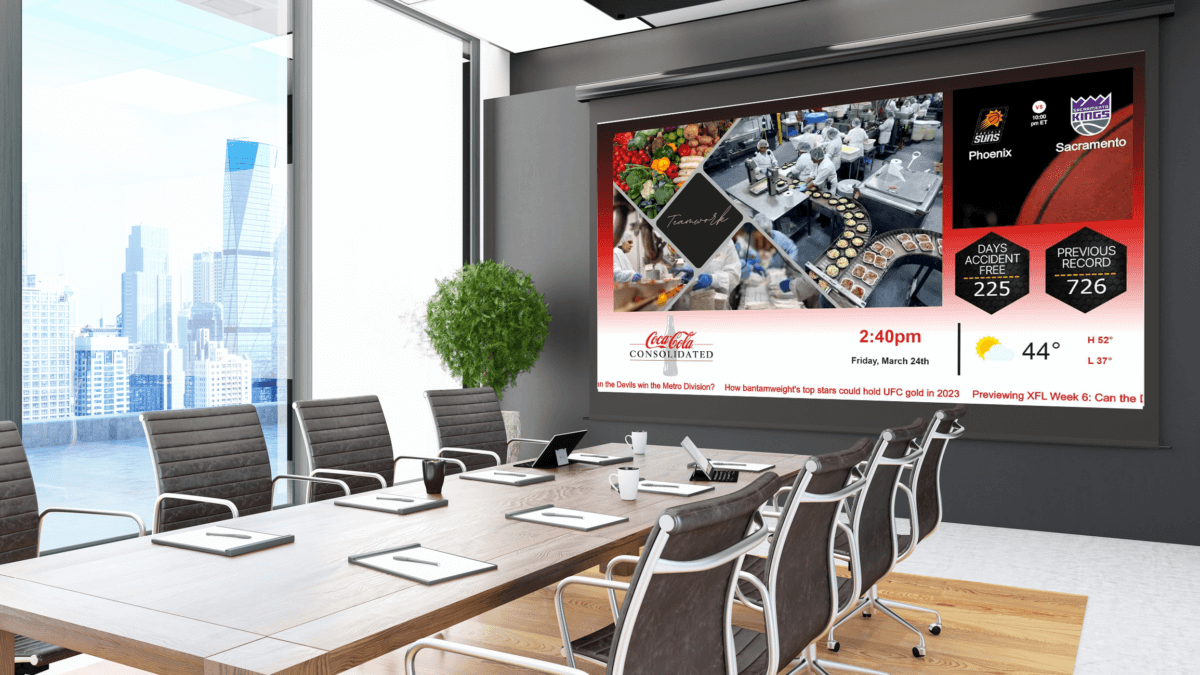AN INTRODUCTION TO DIGITAL AND TRADITIONAL DISPLAYS
As technology continues to offer new ways to connect with audiences, businesses are being forced to weigh the benefits of adopting digital signage displays or maintaining more traditional communication methods. Digital signage platforms allow users to create digital advertisements that can be shared through large TV screens or interactive kiosks. These displays can be vibrant, eye-catching, and concisely organize more information. Traditional displays often come in the form of bulletin boards, banner ads, and brochures. While these have to be manually placed around a facility, they offer a tangible object your audience can interact with. Each communication method has its pros and cons, but ultimately, it is up to you to evaluate these factors and decide which one best suits your strategy. At REACH Media Network, we have analyzed many different communication strategies and have produced a few of the most popular advantages and disadvantages of employing digital signage announcements over traditional displays, and vice versa. By comparing these factors yourself, you will have a holistic view of what is possible through each method and can best decide how to move forward.
However, if you are ready to start your digital signage journey, REACH Media Network has you covered. REACH Media Network is a hardware and software provider, meaning we are equipped to recommend you the best media player that will help accomplish your goals. Of course, our user-friendly software is extremely flexible and integrates with hundreds of third-party software. Through our partnership with Snap Install, we will also handle the installation process of your screens and media players, providing a full turnkey experience. For more useful information, you can browse our resource page for informative blogs, tips, and best practices. If you’d like to see how clients in your industry are already using digital signage, you can visit our templates page to gain some inspiration. Of course, you can always click the button below to begin talking to an expert, today!
SEE DIGITAL SIGNAGE IN ACTION
Want to experience the power of digital signage firsthand? Request a free demo today and explore how REACH Media Network can enhance communication and engagement within your religious venue.
A QUICK INTRODUCTION TO DIGITAL SIGNAGE
While everyone is familiar with poster boards and other traditional communication displays, digital signage is still a relatively new form of communication for most businesses. Hence, before we start listing the pros and cons of signage, it’s probably best that you have a good understanding of what exactly will be discussed throughout this article.
To give a general summary, REACH Media Network believes digital signage is both the hardware, software, and content that come together to produce digital messages on a dynamic display. While many viewers will only see the final product of your signage efforts (I.e. content playing on a screen,) it’s important as a potential user of a signage platform that you understand what’s going on under the hood.
“Software” relates to the content management system you will use to create assets and produce digital messages. These software platforms are usually cloud-based, meaning all your data and content are saved to a “cloud network.” This allows you to publish content remotely from any location so long as you have an internet connection. Cloud technology also guarantees the safety of your created assets, preventing them from being lost or locked to certain hardware. Digital signage software is also usually compatible with third-party software through integrations. By integrating certain software with your signage platform, you can expand your content possibilities or even automate certain processes such as calendars. Even if some integrations do not seem immediately possible, it is worth mentioning to your account manager, as there may be ways to set up a custom integration to get it up and running. Most software platforms also come with a bevy of apps for you to utilize that can also perform certain functions through your displays, such as adding RSS feeds or weather radars. Regardless of what you are looking to achieve through your displays, it is generally recommended to browse a company’s website and see what apps they offer.
The hardware surrounding a signage network is more straightforward to understand, but equally as important. The most popular option we see people display their content on is through large TV screens. However, there are some important guidelines to follow. You will want to ensure you have a full HD (1920 x 1080p) or higher resolution display to make your content clean and appealing. Generally, we recommend screens about 42 inches or larger. LCD, LED, or OLED models are the most popular screens in the industry. Screens should be easily accessible to your audience, placed 7 – 10 feet away from your audience at a vertical viewing angle of about 75 degrees below eye level and 60 degrees above eye level. Realistically, unless you are placing screens in a waiting area, lobby, or breakroom, you will only have a few seconds to make an impression as people walk by. These guidelines ensure your screens provide the most accessible, comfortable viewing experience that encourages engagement.
Of course, you need hardware that will run the content on your screens. That’s where digital signage media players come into play. Media players are mini PCs or streaming devices that connect to your CMS and stream the content to each display. This can come in the form of more traditional media players, to simpler options such as Amazon Fire Sticks. As a reseller and Bright Alliance Premier Partner, REACH Media Network often recommends BrightSign players to its clients. BrightSign players are known as some of the most powerful and reliable on the market, making them an excellent option for any business. REACH Media Network also provides its own DS3 player at an affordable price, making it a great option for entry-level signage users. If you already have hardware that can stream content, you can use that as well, since REACH Media Network’s software is hardware agnostic. Regardless of the route you choose, having a reliable media player will act as the backbone of your entire signage network.
Finally, there’s the content you must create. Most software platforms will provide an in-house announcement editor that will allow you to create fresh content directly from your CMS. REACH Media Network even offers a Canva integration, allowing users to pull from their Canva libraries and use the platform’s suite of features to create content within the REACH Media Network system. Other integrations such as OneDrive can further expand your content organization, while Microsoft and Google Integrations can pull content in from other sources. Calendars, data lists, news headlines, and more can fill out supplemental content pieces to your main announcements. Each content piece should be strategically employed to fit your overall brand message and aesthetic while drawing eyes toward your screens. However, you must avoid cluttering your layouts with too much content. Doing so can overwhelm your audience, which will turn them away from your true message.
By learning these 3 key tenants, you now understand everything that must come together to make digital signage work effectively. The only thing left missing is the people! Selecting a competent and trustworthy team to create content and manage your displays is the most important factor for ensuring the long-term success of a digital signage strategy. Once everything is set up, it is you and your team who are in control. But do not worry. If you ever need assistance, REACH Media Network’s 24/7 support means there’s always someone willing to help.
THE PROS & CONS OF TRADITIONAL DISPLAYS
Now that we’ve spent a good amount of time going over digital signage, let’s switch gears for a bit and talk about traditional displays. To review, traditional signage displays are physical, static objects within their environment. While an older form of communication, they still host a variety of pros and cons.
REDUCED INITIAL COST
PRO
Typically, traditional displays are much cheaper upon initial deployment. These displays don’t require you to go out and buy expensive TV screens, media players, and software subscriptions. Hence, the cheaper cost can be appealing to businesses looking to save some money. If your business rarely changes its signage, producing a simple traditional display that is longstanding around your facility can save on costs even further down the line. Additionally, traditional displays do not require electricity or the internet to function. This has the added benefit of reducing energy costs in the long run.
CON
While traditional displays can initially save some money, they are much less likely to give a good return on investment. Depending on the size, material, and how often you wish to change these displays, you will have to invest time and money repairing displays, swapping them out, repainting, printing new handouts, etc. The labor and production cost of these challenges over time can add up to more than the initial cost of installing a digital signage network. Depending on the materials you use in your physical displays, you may even lose money waiting for the production of your new sign, when you could have been outputting fresh announcements.

SIMPLICITY & RELIABILITY
PRO
Traditional signage displays can be a lot easier for your staff and viewers to understand. Traditional displays do not require training staff on how to utilize new software or set up integrations. With strong branding and aesthetics, viewers can look at a static display and immediately understand its message or objective. They do not have to scan a screen with multiple widgets of content or wait for a slideshow to get to the information they need. This simplicity also plays into a traditional display’s reliability, as you will not have to worry about power outages or other technical issues to ensure your signage is working properly.
CON
While traditional displays can be made out of sturdy materials, they are still prone to vandalism or weather degradation. This would require added repairs, maintenance, or new versions of the display. These traditional signs can take longer to replace or repair than a digital display depending on materials and production time, which can be costly to businesses.
VARIETY IN DISPLAY OPTIONS
PRO
Traditional displays offer way more variety in terms of how they are presented. Digital signage is a bit uniform in this way. Every setup will be on a digital screen. You can have differences in resolution and color through OLEDS, HDR displays, and so on, but they will still revolve around content playing on a screen. However, traditional signage can be produced through paper, cardboard, posterboard, metal, acrylic, wood, plastic, glass, and more. These displays can be quite striking to audiences, drawing them to your business.
CON
As discussed previously, the materials you use can result in a long, costly production process that is only amplified if the sign needs to be replaced or repaired. Such variety can also result in businesses missing the mark, forcing new replacement strategies if the display is not aligning with a business’s goals.
SEE DIGITAL SIGNAGE IN ACTION
Want to experience the power of digital signage firsthand? Request a free demo today and explore how REACH Media Network can enhance communication and engagement within your religious venue.
THE PROS AND CONS OF DIGITAL SIGNAGE
Now that we’ve gone over traditional signage, let’s get back to digital displays. Using the information we went over at the start of this article, we can now effectively analyze some of the pros and cons we see in the digital signage industry. We will even compare some of these to the pros and cons discussed during the traditional signage section.
RETURN ON INVESTMENT
PRO
Digital signage can offer a much greater return on investment in the long run. In a recent survey, 71% of customers stated that digital signage stands out more than traditional displays, with 19% admitting they made impulse purchases after seeing a digital display. By standing out more, your advertisements are more likely to reach higher audience numbers which increase your chances of conversion. If you’d rather be proactive with your display revenue, you can even sell your signage space to other advertisers, opening up another revenue strange. The vibrant nature and flexibility of these displays can draw more people or advertisers, and thus, more purchases to your stores.
Additionally, digital displays require less maintenance since they are generally indoors and shielded from weather hazards. This means maintenance is generally as simple as updating software or dusting off screens.
CON
As stated previously, the initial investment in digital signage can be costly. Purchasing the proper hardware and subscribing to a software provider can be an expensive endeavor. Additionally, if a screen does break, replacing it can be expensive as new models become more advanced.
RELIABILITY & FLEXIBILITY
PRO
Arguably digital signage’s greatest strength, its flexibility gives businesses a lot of freedom in how and when they publish content. Cloud-based CMS technology allows users to upload content to multiple screens or facilities from a central location. This saves time and money on manually updating displays, and the message is displayed as soon as the content is published. These real-time updates ensure customers are always receiving the most up-to-date information, and allow users to make quick adjustments based on time, limited-time promotions, or emergencies.
The reliability of these systems is sound as well. Once the installation process is complete, you can immediately start publishing content without constant maintenance of your screens.
CON
While the flexibility of these systems is fantastic, it still requires time to train users how to use every system effectively. Even then, certain integrations or apps may require additional support to set up properly. Additionally, these systems can be prone to the same technical issues other PCs, internet providers, and televisions can face. Resolving these issues can take time to resolve and may require an onsite visit.
INTERACTIVE ENGAGEMENT OPPORTUNITIES
PRO
A pro that is unique to digital signage displays is the opportunity for interactive engagement options. Interactive displays give consumers the power to control their experience, browsing items, deals, and other promotional assets. For larger campuses, like hospitals or malls, interactive displays can help with wayfinding objectives, guiding visitors around the facility. Even without an interactive touchscreen, you can still employ QR codes for users to scan to get exclusive deals, fill out surveys, or register for events. This can excite users and get them more attached to your brand.
CON
Interactive displays are even more costly than traditional displays, and configuring them properly can involve a more involved installation.
CONCLUSION
With so much to consider, weighing the benefits and drawbacks of both digital signage and traditional signage can be an overwhelming process. Using this breakdown, we hope you have the knowledge to make a more informed choice. Ultimately, digital signage will provide more creative control, user flexibility, and audience engagement over traditional signage. However, traditional signage offers a wide variety of materials and a lower short-term cost. Deciding on what the best choice is for your business based on these factors can set you up for long-term success.
READY TO START YOUR DIGITAL JOURNEY?
Discover how digital signage can transform your religious community. Reach out to REACH Media Network today to learn more about our solutions, explore custom integrations, and see how we can help you connect with your congregation in meaningful ways.


